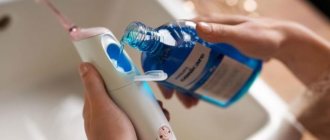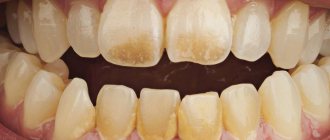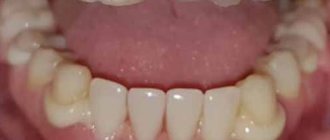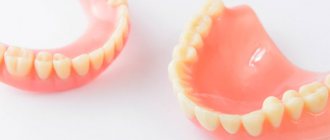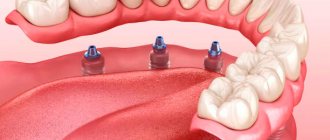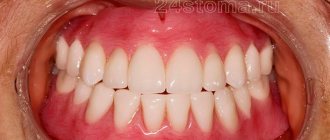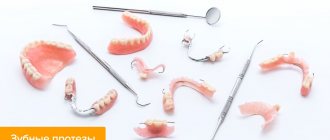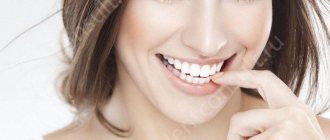After the manufacture and installation of the orthopedic structure, the dentist teaches the patient the rules of use and care. In particular, he tells how to clean dentures from dirt. Recommends means for this, shows the correctness of cleaning actions. Below you can find information of this kind or refresh your memory of previously acquired knowledge.
Review of the best ways to whiten and clean dentures – at home and in the dental clinic
Article navigation
- Why do you need care?
- What happens if there is no care
- Basic storage rules
- Cleaning methods
- Cleansing and whitening at home
- - Toothbrush
- – special pastes and gels
- - tablets and solutions
- - ultrasonic bath
- Professional cleansing in the clinic
- Is it worth using folk remedies?
- - citrus juices and citric acid
- - baking soda and hydrogen peroxide
- Side effects due to inappropriate medications
- How to maintain the aesthetics of your smile
- User Questions
Question to a specialist
Dentures are placed in order to restore the aesthetics and chewing function of the dental system.
But active or improper use of orthopedic structures can lead to the appearance of stains and plaque on them. Can dentures be whitened? Cleaning artificial “jaws” – plastic, acrylic, etc. – to their original appearance is quite problematic, but possible. Next, we will tell you how to clean them from tartar, blackness and yellowness, pigmentation, and what is better to use - folk remedies at home or still turn to professionals in dentistry.
Why does dark plaque appear?
Typically, dark areas on dentures are the result of plaque. The latter spreads very actively in the absence of sufficiently frequent cleaning of the structure.
So, plaque is formed from:
- leftover food;
- cigarette smoke;
- dead bacteria and cells;
- food colors.
On a note! It is advisable to use a simple toothbrush with soft bristles for mechanical cleaning of dentures. The use of tooth powder is also allowed. Daily cleaning itself, by the way, is very important - if this is not done, then it will be much more difficult to remove plaque in the future.
Also remember that there are special toothpastes for dentures.
Why do you need care?
In short, caring for removable orthopedic structures is necessary so that they maintain an attractive appearance and functionality. And also so that a person can communicate with others without hesitation, without worrying about bad breath. High-quality care is required to maintain normal microflora in the oral cavity, i.e. so that harmful microorganisms do not prevail over neutral and beneficial ones. Timely removal of soft and hard plaque also eliminates a potential source of infection, because they are inhabited by a large number of pathogenic bacteria. That is, adequate care protects against inflammation in the oral cavity and infections. And what will happen in his absence, we will tell further.
Ultrasonic baths
This method involves treatment with ultrasonic waves. You need to purchase a device, the average cost of which is about 2 thousand rubles.
Ultrasonic Cleaner SD-3000
Operating principle: ultrasound is passed through the liquid in which the dentures are placed. Bubbles form and penetrate deep into the pores of the teeth.
Result:
- plaque is eliminated, including dark plaque caused by excessive consumption of tea and coffee;
- the unpleasant odor disappears;
- the surface of the structure remains undamaged.
Note: bathtubs are quite suitable for cleaning baby bottles and gold and silver jewelry. So the purchase costs will be justified in any case.
What happens if there is no care
Installing a new and beautiful denture can give a person the deceptive feeling that the artificial structure will always be like this and there is no need to take special care of it. But this opinion is wrong, because the characteristics of the materials (for example, the presence of micropores on the surface) and the lack of regular cleaning and disinfection are a direct path to the appearance of age spots and the formation of tartar on the teeth. Moreover, it is impossible to remove the stone even with a special brush and paste at home. The result will be the following manifestations:
REPROSTHETICS WITH ACRYLIC PROSTHETICS - RUB 200,000.
Re-prosthetics with an acrylic bridge on a metal frame (all included) up to 12 units.
Save RUR 30,000. Call now or request a call
- decreased smile aesthetics,
- stomatitis due to the influence of microbes on the mucous membranes,
- destruction of supporting teeth: caries occurs due to cariogenic bacteria,
- risk of breakage of the prosthetic base: stone build-ups can reduce the strength properties of materials, especially elastic ones - plastics, nylon, acrylic,
- penetration of harmful microbes into the stomach and intestines: inflammatory processes occur, beneficial substances are less absorbed, and the body’s immune defense weakens.
Features of dark plaque removal
Nicotine, coloring foods/drinks, or simply long-term use leads to the formation of plaque on artificial crowns, which does not have the best effect on your smile. Do not ignore dark plaque under any circumstances, otherwise the problem can quickly spread to the mucous membrane and real teeth, causing inflammation. What actions need to be taken?
- First of all, this is the regular cleaning of the prosthesis already mentioned above. This should be done regularly, the minimum cleaning time is 10 minutes. You can use special toothbrushes and brushes to completely remove plaque.
- You can also buy tablets at any pharmacy, which, after dissolving in water, perfectly clean the denture from the accumulation of bacteria. Moreover, these tablets also have a whitening effect.
- If the methods listed above do not help get rid of plaque, visit the dental office, where a specialist will use more effective means.
Basic rules for storing removable systems
Most modern removable dentures are stored directly in the mouth. For example, in principle, it is not necessary to remove clasp, Quattro Ti (“Quadrotti”), sandwich dentures at night and even every day - by the way, that’s why they are often called conditionally removable. Full or partial removable ones made of acrylic, nylon or Acry-free (“Acry-free”) can also be left in place at night. But any orthopedic structure needs to be cleaned at least 2 times a day! A well-cleaned product is dried with a paper or cloth towel and, if necessary, stored in a container. It is advisable to purchase a special one, which can also be used as a cleansing bath.
Read more about how to store dentures correctly so that they last as long as possible and maintain an attractive appearance.
Installation of veneers and lumineers
As mentioned earlier, ceramic and plastic crowns are practically not amenable to any of the modern methods of whitening; they can only be cleaned of dirt accumulated on the surface. That is why many patients prefer using more advanced methods of dental restoration, for example, installing veneers.
Veneers are invisible overlays on the frontal area of the teeth, which are fixed using a special dental glue. With their help, you can easily disguise small chips, cracks, darkening of the enamel, as well as slight curvature and even gaps between teeth. These linings are made from very durable and resistant to external influences materials.
An even more reliable and aesthetically attractive option is lumineers. These are exactly the same pads, but thinner. Thanks to this, pre-grinding of the units is not required. Each of these prosthetic options involves taking impressions of the jaw, on the basis of which the onlays themselves are subsequently made. Quite often, doctors prefer to install veneers directly, that is, using a composite material and directly in the patient’s mouth.
Methods for cleaning products
How to clean dentures? There are several methods of cleaning and bleaching - physical (mechanical, temperature, ultrasonic) and chemical. They are most often used in combination both at home and in the office of a hygienist or orthopedic dentist. Let's take a closer look at how to clean removable dentures from plaque and pigmentation.
Cleaning and whitening removable dentures at home
How to clean removable dentures at home from tartar, dark and yellow plaque, and nicotine? Here a special brush or a regular soft one, special solutions (tablets, powders), and an ultrasonic bath are used. It is recommended to use them comprehensively, i.e. All these devices and tools should be at home.
Toothbrush – special or regular soft
The brush cleans the surface mechanically, and you can use it to whiten teeth on a removable denture if the contamination is light, the plaque is soft and fresh, and there is no stone. The head of the instrument and the prosthetic device itself are moistened with warm water (no more than 60 degrees Celsius), and cleansing is carried out using sweeping movements.
Here is a list of useful tips that will tell you how to properly clean removable dentures at home:
- removable ones made of acrylic, nylon are cleaned by removing them - i.e. holding the structure in one hand and the brush in the other,
- conditionally removable (clasp, “sandwiches”) can be cleaned both in the mouth and in the hand - but in the latter case, not every day, but about once a week,
- You will need to remove the “jaws” in any case - you can never wear them without removing them: because Plaque and stone also accumulate under the base. In order for it to form less, it is necessary to exclude sticky foods (taffy, for example) and rinse your mouth after each snack,
- it is preferable to use an irrigator, which, due to a directed stream of water, cleans the most inaccessible places,
- Finally, you need to rinse the product in clean water or rinse your mouth (if it was cleaned in your mouth).
Special pastes and gels
How to clean dentures at home? In addition to a special brush, orthopedic dentists recommend using additional products - pastes (for children or specialized). Their main purpose is to remove soft food plaque, eliminate harmful microorganisms, and freshen the oral cavity for a long time.
Orthopedic toothpastes and gels are used on a daily basis along with a brush. One or two peas of the product should be applied to the damp bristles and begin cleaning the structure. After thoroughly working all areas, rinse the product in clean water or rinse your mouth. Popular brands of cleaning products are CURAPROX daily, Corega, Silcamed, ROCS. Their composition is quite gentle and does not contain harmful or brightly colored components, so that prosthetic materials with cracks on the surface do not acquire an unnatural shade.
When understanding how to clean and how to whiten dentures that have darkened, you need to understand that toothpastes will not cope with whitening stubborn pigmentation and tartar. But they are quite suitable for maintaining an aesthetic appearance. Use regular whitening pastes with an RDA (abrasiveness) index of more than 100 units. prohibited - they will scratch the acrylic gum or plastic of artificial teeth. Pastes and gels with a whitening effect, which contain a high concentration of carbamide peroxide or hydrogen peroxide, can spoil materials.
Tablets and solutions
What else can you use to clean dentures? A more effective or deep cleansing method is weekly soaking in a special solution. Some manufacturers produce ready-made solutions for cleaning and whitening - for example, CURAPROX weekly, Isodent. They, like pastes, will help with not very strong and recent darkening and pigmentation. Such solutions are used in conjunction with storage containers and ultrasonic baths. The maximum effect is observed from solutions that need to be made on the basis of whitening tablets for dentures - for example, Protefix, Dent Frash, Fittydent super, Corega Whitening.
The prosthetic structure must be immersed in the solution for 5-15 minutes. It is made like this: 1 tablet + 150 ml of warm water no more than 60 degrees Celsius. Cleaning, disinfecting and bleaching the product is achieved through the action of the active substances of the solution - released oxygen, silver ions, enzymes, sodium perborate, citric acid and soda (each manufacturer uses a different combination of components). After soaking, the product is cleaned with a brush dipped in the solution, washed with water, and the solution is immediately poured out after use.
Ultrasonic bath
As an addition to the brush, pastes and solutions, you can use an ultrasonic bath or “wash” once every 1-2 weeks. Bradex brand bathtubs have proven themselves well. A nice bonus is that you can clean jewelry in them without worry.
Professional cleansing in the clinic
How and with what to whiten removable dentures in the clinic? Dentists have powerful tools at their disposal, incl. ultrasonic, devices that can clean almost all types of dirt, plaque, large amounts of stone. But provided that the pigment is not old - otherwise the denture cannot be bleached to its original state! For example, even professional methods will not help against blackness that has formed on teeth for a very long time. The structure will whiten only a few shades, but not to perfection.
Using hardware, you can bleach and clean classic plastic and acrylic orthopedic structures, modern “Acry-free” and “Quadrotti”, acetal, and polyurethane. An ultrasonic bath, for example, Easyclean, has a wave frequency of 37 kHz (this is 7 times more powerful than a device for home use). How to clean dentures with it? The contaminated product is lowered into it, filled with liquid - and during the cleaning process it can heat up to 80 degrees Celsius, and ultrasonic waves knock down pigmented plaque and stone.
Another highly efficient device is the Sympo from Renfert. The denture is placed in a special glass, at the bottom of which there are many metal needles, filled with liquid, closed and placed in the device. The operating principle is based on a rotating magnetic field. Under its action, the needles begin to move and remove all organic growths on the prosthesis without damaging the product itself. Suitable for cleaning and whitening stubborn stains, smoker stains, and for lovers of strong coffee.
Is it worth using folk remedies?
Often people, in search of what to clean and how to whiten dentures[1] made of plastic, acrylic, nylon at home, decide that nothing can be better than folk remedies. Acetic acid, salt, activated carbon, tooth powder, soda, peroxide, citric acid and even a microwave are used. But, according to experts, careless and improper use can cause irreparable harm to artificial teeth (and natural ones too), gums, and fastening elements. The orthopedic structure may crack or become stained. Therefore, the choice between improvised folk remedies and pharmaceutical drugs with carefully selected composition should still be inclined in favor of the latter.
Citrus juices and citric acid
How to clean dentures with citric acid? To do this, take citric acid on the tip of a knife and mix with 1-2 peas of toothpaste or a small amount of tooth powder. Citric acid can be replaced with 1 teaspoon of freshly squeezed lemon or orange juice. Then apply the mixture with a brush to the product and leave for 15-20 minutes. Then clean it with a brush and rinse in running water.
Baking soda and hydrogen peroxide
For this method, you should take 1-2 teaspoons of soda (baking soda only), a little water and hydrogen peroxide - literally a few drops each. Gradually add the liquid to the soda and mix to form a slurry - then it is applied to the structure with a brush and cleaned. The method may help whiten dark plaque, but large particles of baking soda powder will leave scratches on the product.
How to properly store dentures
Many of us remember how grandmothers, when going to bed, took off their dentures and placed them in a glass of water overnight. Why was this necessary?
Previously, rubber was used in the manufacture of chewing structures. It had to be kept in a humid environment, otherwise it would dry out and become cracked. Today there is no need to give prosthetics such a bath. Moreover, if you put metal-ceramic dentures in a container with chlorinated water, they will darken.
Modern plastic prosthesis
How then should you store your dentures? In many cases there is no need to remove it at night. On the contrary, dentists recommend wearing it constantly. If the doctor advises you to take a short rest at night, put your teeth in a special container with disinfectant liquid.
Side effects due to unsuitable whitening products
Side effects from the wrong selection of cleaning or bleaching agents can damage the prosthetic structure to such an extent that it loses its attractive appearance and functionality. Consider the dangerous consequences:
- the appearance of scratches and cracks on the product,
- the appearance of white, colored or dark spots on artificial teeth, gums, metal components,
- unpleasant taste or burning in the mouth,
- allergic reactions, stomatitis,
- displacement or breakage of clasps,
- deformation and destruction of the orthopedic structure.
“I’m already used to using cleaning tablets - it’s convenient and the results from them are noticeable. The paste didn't help much. And I soak the plastic in the solution a couple of times a week and everything is fine. I've been using it for 2 years now and it looks just like my teeth. But I also go to the dentist for professional cleaning, otherwise I can’t remove the stone with a simple brush.”
Irina P., review from gidpozubam.ru
Advice from Dr. Zubastik
Modern dentures are high-quality products, most often made of acrylic and nylon, sometimes with the addition of metal elements. Caring for them is easy and does not require time. The main thing here is regularity. If you clean your dentures as recommended by your doctor, they will last 5-10 years until they are scheduled for replacement, and your smile will be perfect during that time.
Couldn't save your teeth? Don’t despair: today dentistry offers designs that are almost in no way inferior to real teeth. But take care of them carefully: they require care just like living teeth. All dentists will agree with me on this.
For starters, a short video that will help you quickly master the rules of caring for dentures.
Tags: Dentures
About the author: Dr. Zubastik
Typically, a toothache begins to subside on the way to the clinic and finally goes away after 10 minutes of sitting in line to see the dentist.
- Related Posts
- What does darkening of teeth mean in adults and children?
- Brown plaque on teeth: a nuisance that is easy to get rid of
- A tooth hurts under a crown: what to do?
« Previous entry
The best ways to preserve and maintain smile aesthetics
What is the best way to clean removable dentures? If they are very dirty, or there are stone build-ups, then the only possible way to whiten is to go to the dentist for hardware cleaning. But even here it is not always possible to return restorations to their original shade. To prevent loss of aesthetics, it is necessary to regularly clean artificial teeth at home - with a special brush, paste, and disinfectant solutions. The dentist will advise which product is best to use at home after prosthetics. It is also recommended to treat brightly colored foods and drinks without fanaticism, to give up cigarettes or reduce their quantity - in any of the above situations, oral hygiene should be strengthened.
Prevention
To ensure that fillings and crowns do not change their color or lose their attractiveness over time, it is very important to properly care for them. Care involves daily oral hygiene (morning, evening, and after each meal). It is also very important to remember to visit your dentist regularly for checkups.
In addition to the timely detection of enamel and gum diseases, the doctor can carry out preventive cleaning. If a patient has a bridge installed in their mouth, they should rinse the area between the crown and the gum tissue as often as possible. In this case, you can use a device such as an irrigator.
Other recommendations include abstaining from eating solid and coloring foods, strong coffee and black tea, red wine, quitting smoking and other bad habits. It is important to avoid strong temperature changes, as this can lead to loosening of the material and its darkening in the future.
previous post
Is it possible to treat teeth with stomatitis?
next entry
Frequently asked questions from users
Question from Tatyana R.: Hello, is it possible to whiten dentures with whitening strips? I have clasps, and my teeth are darkened on them, and the toothpastes don’t help at all.
ANSWER: Hello, Tatyana. Using whitening strips, you can seriously harm your supporting teeth and gums if the active gel from them penetrates under the denture. Even if there is a microscopic gap between the hooks or attachments and the gum, this is quite likely. If you whiten the denture in strips after removing it from your mouth, this is also not the best solution - stains and cracks may appear on the base and teeth. To clean orthopedic structures, it is better to contact dentistry. The doctor will assess the condition of the dentures, clean and polish them using professional methods. But if the pigmentation has penetrated very deeply into the coating, repair or replacement of the prosthesis may be required.
[1] Lebedenko I.Yu. Prosthetic Dentistry: National Guidelines, 2021.
Author: Dulgarov Zh. G. (Thank you for your help in writing the article and the information provided)
